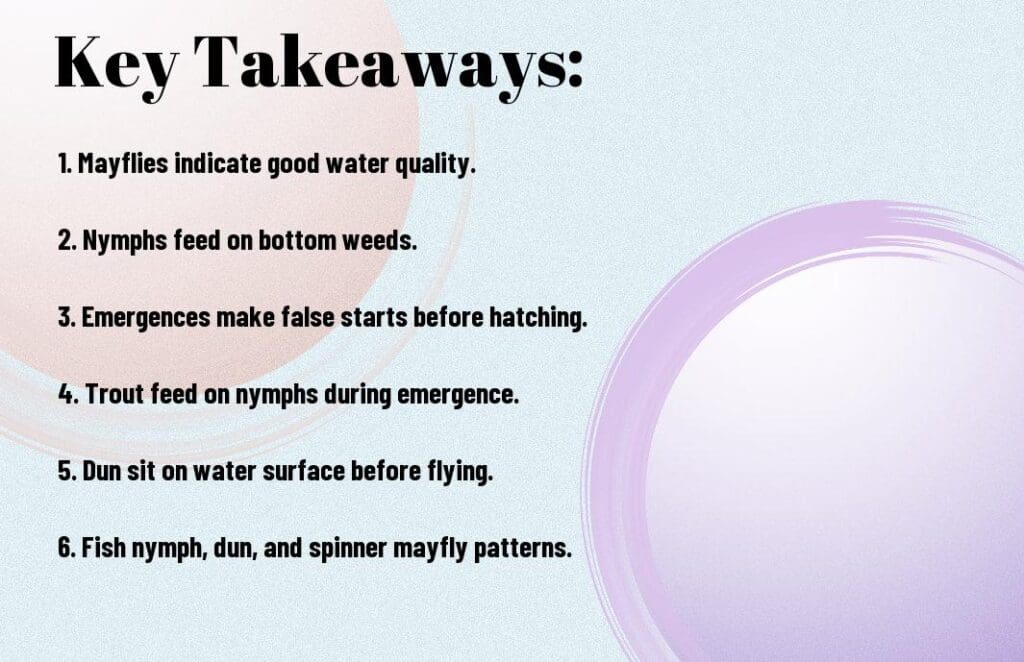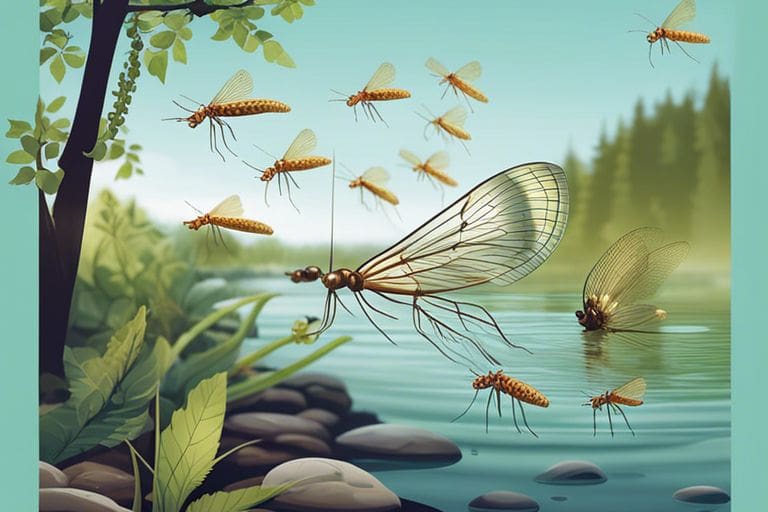Just beneath the surface of freshwater lakes and rivers lies a world teeming with Mayfly nymph, integral to the balance of the ecosystem’s delicate web of over 600 species. These pollution-sensitive creatures are a barometer for water quality, thriving in pristine environments. The intriguing life cycle of Mayflies consists of underwater stages as eggs and nymphs, followed by terrestrial stages as duns and spinners. But the nymph stage holds the key to unlocking the heart of rivers, influencing the behaviour of trout and guiding the art of fly fishing enthusiasts worldwide.
Key Takeaways:
- Importance of Mayflies: Due to their pollution sensitivity, they are important water quality indicators.
- Mayfly Life Cycle: Understanding the Mayfly life cycle, from nymph to dun to spinner, is crucial for successful fly fishing.
- Fly Fishing Tips: Tips for fishing Mayfly nymphs, duns, and spinners include presentation techniques and fly patterns.
Fly Fishing Mayfly Nymph Behaviour
Identifying Key Characteristics of Nymph Activity
You may often spot Mayfly nymphs feeding and growing amongst bottom weeds in water depths ranging from a few feet to twenty-five feet. These nymphs undergo several instar stages before reaching maturity, which can take several months to a few years. With over 600 species in North America alone, the Mayfly is extremely sensitive to pollution, making their presence a strong indicator of good water quality.
Seasonal Variances and Behavioural Patterns
Characteristics of their behaviour can vary depending on the season. Trout will feed on the nymphs from the bottom to the water’s surface, with peak emergence times usually around midday in cloudy conditions, from mid-spring to mid-summer, and again in early to mid-fall. Understanding these seasonal patterns and behaviours can significantly impact your success in fly fishing for Mayflies.
Strategies for Fly Fishing with Mayfly Nymphs
Reading the Water for Nymph Activity
Water is the key element in determining where to find Mayfly nymphs. Look for areas with bottom weeds where they typically feed and grow, ranging from shallow to depths of up to twenty-five feet. Watch for signs of nymph activity, such as casings and newly hatched duns on the water’s surface, indicating a hatch is in progress. Trout will begin feeding on nymphs near the bottom before emergence, so observe their behaviour to pinpoint the best fishing spots.
Selecting the Right Gear and Techniques
On the subject of gear and techniques, choosing the right equipment is crucial for successful nymph fishing. When fishing in water up to 10 feet deep, opt for a floating line with a sinking tippet or weighted fly for a quick presentation. A Type II sinking line with a longer leader is more effective for deeper waters. Additionally, using nymphs like the Halfbacks, 52 Buick, or Hares Ear Nymph in sizes #8 to #16 with different body colours can attract trout’s attention.
Mastering Mayfly Nymph Fly Presentation
For those looking to master their fly fishing, honing your fly presentation skills is crucial. Consider studying the East Walker Mayfly nymph Trout for inspiration and techniques to excel.
Perfecting the Dead Drift
Perfecting the dead drift is a necessary technique for successful Mayfly nymph fishing. Achieving a natural drift is critical to enticing trout to strike, mimicking the nymph’s natural behaviour as it flows along the water’s current. Focus on maintaining a drag-free drift to increase your chances of a successful catch.
Implementing Effective Nymphing Rigs
Rigs play a vital role in successful Mayfly nymph fishing. Crafting balanced and effective nymphing rigs can significantly improve your chances of landing that prized trout. By selecting the right combination of nymph patterns and weights, you can effectively mimic the Mayfly nymph’s movement in the water, increasing your chances of a strike.
Crafting and Choosing Mayfly Nymph Patterns
Essential Mayfly Nymph Flies for Your Box
Choosing the right mayfly nymph patterns for your fishing expedition can make all the difference in your success on the water. Key patterns like the Halfbacks, 52 Buick, and Hares Ear Nymph are imperative additions to your fly box, offering versatility and effectiveness in mimicking the natural insects present in freshwater lakes and rivers.
Tips for Tying Effective Mayfly Nymph Imitations
Attention to detail is crucial when crafting mayfly nymph imitations. Focus on using natural colours like Olive Green, Light and Dark Brown, and Dark Grey to match the naturals you find in the water. Incorporate realistic features such as wing cases and body shapes to create lifelike imitations that trout can’t resist. After tying your fly, ensure it has the necessary weight to mimic mayfly nymphs’ underwater behaviour effectively.
Mastering the Hatch: Expert Fly Patterns & Fishing Techniques Unveiled
Summing up
With these considerations in mind, it is clear that understanding the life cycle and behaviour of mayfly nymphs and adults is imperative for successful fly fishing. As pollution-sensitive insects, Mayflies thrive in good-quality freshwater environments, making their presence a good indicator of water health. By knowing when and how to fish nymphs, duns, and spinners, anglers can effectively target trout during different stages of a mayfly hatch. Matching fly patterns to the natural colours of these insects can increase the chances of a successful catch. So, next time you’re out on the water, armed with the knowledge of mayfly secrets, you can unlock the heart of rivers and have a rewarding fly fishing experience.
FAQ
Q: What is a Mayfly Nymph?
A: A Mayfly nymph is the juvenile stage of a Mayfly, found in freshwater lakes and rivers. The nymph lives underwater and feeds and grows before emerging as an adult.
Q: How long does a Mayfly nymph’s maturity take?
A: The Mayfly nymph goes through several instars and takes a few months to a couple of years to reach maturity, with the average being about one year.
Q: Why are Mayflies important in determining water quality?
A: Mayflies are very pollution-sensitive, so their presence or lack thereof indicates water quality. If Mayflies are present, it suggests that the water is good quality.
Gratitude and Exploration: Furthering Mayfly Nymph Knowledge
Thank you for exploring “Mayfly Nymph Secrets: Unlock the Heart of Rivers.” Your curiosity shines a light on the crucial role of Mayfly Nymph in river ecosystems. We urge you to spread this insight.
Additionally, we invite you to delve into more intriguing articles at sunnydaysgo.com.
- Discover the enchanting world of nymph fishing in “What is a Nymph | Discover Fly Fishing Magic.” Learn what makes nymph fishing a magical experience.
- Get ahead of the game with “Bow River Hatch Chart 2024: Master the River Now!.” Master the Bow River with our detailed hatch chart.
- Experience the allure of “Boulder Lake: A Fishing Paradise in Blackfalds, Alberta.” Explore why Boulder Lake is a must-visit for anglers.
- Enhance your fishing technique with “Fly Patterns | Unlock Better Fly Fishing Today.” Learn about fly patterns that promise better fishing outcomes.
- Unravel the mystery behind hatches in “What is a Hatch? | Unlock Pro Mystery Today.” Understand what a hatch is and how it affects fishing.
Explore these links to expand your knowledge and skills in the captivating world of fly fishing and conservation.


